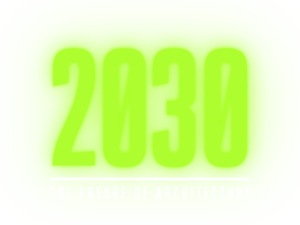
A FREE COURSE TO THE FOREFRONT OF ARCHITECTURE INNOVATION
A FUSION OF SUSTAINABLE DESIGN, HIGH-PERFORMANCE BUILDINGS, AND ARTIFICIAL INTELLIGENCE
JULY 8TH TO 12TH, 2024
ONLINE AND FREE EVENT
JULY 8TH TO 12TH, 2024
ONLINE AND FREE EVENT
By clicking the button, you agree to our Terms of Use and Privacy Policy, including the use of cookies and the sending of communications.
The built environment significantly impacts the planet and people’s quality of life.
Green architecture, also known as sustainable or eco-friendly, is a design philosophy that seeks to minimize the negative environmental and social impacts of buildings and structures and create healthy, comfortable, and resource-efficient spaces.
Green architects use various strategies and technologies to achieve these goals, such as using energy-efficient materials and systems, reducing water consumption, minimizing waste and pollution, and designing healthy and comfortable buildings for occupants.
If you are interested in learning more about green architecture and how it can benefit the environment, people, and the economy, this article is for you.
In it, we will explore the main principles of green architecture, the skills and qualifications that green architects should have, and the steps you can take to become a green architect or find a green architecture firm in your area.
We will also discuss how you can make your existing building or home more sustainable and energy-efficient, with or without the help of a green architect.
By reading this article, you will gain a deeper understanding of green architecture and its role in creating a more sustainable and equitable built environment.
We hope it will inspire you to learn more about this exciting and vital field and consider ways you can contribute to developing green architecture in your community.
Before understanding what a green architect is. What is green architecture?
Green architecture, also known as sustainable or eco-friendly, is a design philosophy aiming to minimize the negative environmental impact of buildings and structures. Green architects use a variety of strategies to achieve this goal, such as using energy-efficient materials and technologies, reducing water consumption, minimizing waste and pollution, and designing healthy and comfortable buildings for occupants.
One of the main principles of green architecture is to use resources efficiently and minimize the use of non-renewable resources. This can involve designing energy-efficient buildings using renewable energy sources, such as solar panels or wind turbines.
Green architects also consider the materials used in construction and strive to use sustainable, low-impact materials that can be recycled or reused.
In addition to environmental concerns, green architecture also considers the health and well-being of the people who use the building. Green buildings often have good indoor air quality, natural lighting, and access to natural spaces, which can improve occupants’ mental and physical health.
Green architecture can also contribute to social and economic sustainability by creating jobs, boosting local economies, and providing affordable housing.
Green architects need a range of skills and knowledge to design and build sustainable structures. They should be familiar with green building standards and certification systems, such as LEED (Leadership in Energy and Environmental Design) or Passive House. They should also strongly understand building science, materials, technologies, and energy-efficient design principles.
To become a green architect, you typically need a professional degree in architecture and a license to practice. Some schools and universities offer specialized programs in sustainable design, and professional development opportunities and certifications are available for experienced architects who want to deepen their knowledge of green architecture.
In conclusion, green architects are professionals who design and build structures that are environmentally responsible, energy-efficient, and healthy for people. They use a variety of strategies and technologies to minimize the negative impact of buildings on the environment and create sustainable and beneficial spaces for all stakeholders.


What skills and qualifications should a green architect have?
Green architects, also known as sustainable architects or eco-friendly architects, are professionals who design and build environmentally responsible and energy-efficient structures.
To be successful in this field, green architects need a range of skills and qualifications that enable them to create innovative and sustainable designs, understand and use green building technologies, and meet the needs and expectations of clients, regulators, and the public.
Here are some of the primary skills and qualifications that a green architect should have:
- Professional degree in architecture: Most green architects have a bachelor’s or master’s degree from an accredited program, typically taking five to seven years to complete. A degree in architecture provides a solid foundation in design principles, building materials, construction methods, and other aspects of the built environment. It also enables architects to obtain a license to practice, which is required in most states and countries.
- Knowledge of green building standards and certification systems: Green architects should be familiar with standards and certification systems that promote sustainable design, such as LEED (Leadership in Energy and Environmental Design) or Passive House. These systems provide guidelines, criteria, and performance benchmarks for designing and constructing energy-efficient, water-efficient, healthy, and environmentally friendly buildings. Green architects should be able to understand and use these systems to create facilities that meet or exceed the required standards.
- Understanding of building science and technology: Green architects should have a strong knowledge of building science and technology, including how buildings function and interact with the environment. This includes understanding how facilities use energy, water, and other resources and how these resources can be conserved and used efficiently. Green architects should also be familiar with the latest technologies and materials supporting sustainable design, such as low-energy systems, renewable energy sources, and sustainable materials.
- Robust design and problem-solving skills: Green architects need to be creative and innovative in their plans and able to develop solutions to complex design challenges. They should have a strong aesthetic sense and the ability to create visually appealing and functional spaces. They should also be able to think critically and analytically and apply design thinking to solve real-world problems.
- Communication and teamwork skills: Green architects often work in teams with other professionals, such as engineers, contractors, and consultants. They need good communication skills to collaborate effectively and explain their designs and ideas to clients, colleagues, and the public. They should also be able to work well under pressure, manage their time effectively, and meet deadlines.
In addition to these skills and qualifications, green architects should also have a passion for sustainability and a commitment to improving the built environment.
They should be proactive and proactive in seeking new opportunities to learn and grow and contribute to the advancement of green architecture.
How can I become a green architect or learn more about green architecture?
Green architecture, also known as sustainable or eco-friendly, is a design philosophy aiming to minimize the negative environmental impact of buildings and structures.
If you are interested in becoming a green architect or learning more about green architecture, there are several steps you can take to pursue this path.
Here are some suggestions for how to become a green architect or learn more about green architecture:
- Get a professional degree in architecture: The first step to becoming a green architect is to earn a professional degree in architecture. This typically involves completing a five-year bachelor’s or two-year master’s program at an accredited school or university. During your studies, you will learn about design principles, building materials, construction methods, and other aspects of the built environment. You will also have the opportunity to take elective courses or specialize in areas such as sustainable design or green building.
- Obtain a license to practice: In most states and countries, you must be licensed to practice as an architect. To obtain a permit, you typically need to complete a degree in architecture, pass the Architect Registration Examination (ARE), and meet other requirements set by the licensing board in your jurisdiction. Obtaining a license is essential in your career as an architect, as it allows you to legally offer your services to the public.
- Enhance your knowledge of green architecture: To become a green architect, you must have a strong understanding of green building principles and technologies. You can learn about these topics through coursework, internships, workshops, and other learning opportunities. You can also join professional organizations such as the U.S. Green Building Council (USGBC) or the International Council for Local Environmental Initiatives (ICLEI), which offer resources, events, and networking opportunities for green architects.
- Gain practical experience: To build your skills and credibility as a green architect, you should seek opportunities to gain valuable experience. This can involve interning with a green architecture firm, working on green building projects as a volunteer or assistant, or participating in design competitions or research projects. You can also consider joining a co-op or study abroad program, which can provide valuable hands-on experience and exposure to different approaches to green architecture.
- Stay current with developments in the field: The field of green architecture is constantly evolving, with new technologies, materials, and approaches emerging all the time. To stay current and competitive as a green architect, you should keep up to date with the latest developments in the field. This can involve reading trade publications, attending conferences and workshops, and participating in professional development programs.
By following these steps, you can become a green architect or learn more about green architecture and contribute to developing a more sustainable built environment.




A FREE COURSE TO THE FOREFRONT OF ARCHITECTURE INNOVATION
A FUSION OF SUSTAINABLE DESIGN, HIGH-PERFORMANCE BUILDINGS, AND ARTIFICIAL INTELLIGENCE
JULY 8TH TO 12TH, 2024
ONLINE AND FREE EVENT
JULY 8TH TO 12TH, 2024
ONLINE AND FREE EVENT
By clicking the button, you agree to our Terms of Use and Privacy Policy, including the use of cookies and the sending of communications.
How can I find a green architect or a green architecture firm in my area?
If you are looking to hire a green architect or find a green architecture firm in your area, there are several steps you can take to locate qualified professionals who can meet your needs and preferences.
Here are some suggestions for how to find a green architect or a green architecture firm in your area:
- Use online directories and databases: Some several online directories and databases can help you locate green architects and green architecture firms in your area. For example, you can use the Find a Pro directory on the U.S. Green Building Council (USGBC) website to search for green architects and firms by location, specialization, and other criteria. You can also use the search function on the American Institute of Architects (AIA) website to find architects who are members of the AIA and who may have an interest in or expertise in sustainable design.
- Ask for recommendations from colleagues, friends, or local organizations: If you know someone who has worked with a green architect or a green architecture firm, they may be able to provide you with a recommendation or referral. You can also ask for advice from local organizations involved in green building or sustainability, such as a green business network or a green building council.
- Contact local or national professional organizations: Professional organizations such as the American Institute of Architects (AIA) or the Royal Institute of British Architects (RIBA) may be able to provide you with information about green architects or firms in your area. Some organizations have directories or referral services to help you find architects who meet your needs. You can also contact the local chapter of a professional organization to ask for recommendations or advice.
- Look for green building certification: One way to identify green architects or firms is to look for green buildings certified by a recognized certification system, such as LEED (Leadership in Energy and Environmental Design) or Passive House. These certification systems provide a way to verify that a building meets specific standards for sustainability and energy efficiency. The architects and firms designing and constructing these buildings will likely have green architecture expertise.
- Research and compare firms: Once you have identified a few potential green architects or firms, you can research and compare their qualifications, experience, and portfolio of work. You can visit their websites, read their online reviews and ratings, and contact them to ask about their services and fees. You can also ask them for references or case studies to better understand their work and how they approach green architecture.
By following these steps, you can find a green architect or a green architecture firm that meets your needs and can help you create a sustainable and energy-efficient building or structure.


How can I make my existing building or home more sustainable and energy-efficient, with or without the help of a green architect?
If you want to make your existing building or home more sustainable and energy-efficient, there are many steps you can take, with or without the help of a green architect. While some of these measures may require significant investments or changes to the building, others can be implemented quickly and inexpensively and yield substantial savings in energy costs and environmental impacts.
Here are some suggestions for how to make your existing building or home more sustainable and energy-efficient with a green architect:
- Conduct an energy audit: An energy audit is a comprehensive assessment of a building’s energy use and efficiency, and it can help you identify opportunities to save energy and money. An energy audit typically involves inspecting the building’s mechanical systems, lighting, insulation, and appliances and reviewing utility bills and other data.
- You can hire a professional energy auditor or use online tools and resources to conduct an audit yourself. An energy audit can help you prioritize the most cost-effective and impactful measures to improve the building’s energy efficiency.
- Upgrade lighting and appliances: Replacing inefficient lighting with more energy-efficient models can significantly reduce energy consumption and costs. Look for products with the Energy Star label, indicating that they meet strict energy efficiency standards. You can also consider installing energy-efficient windows, doors, and skylights to reduce heat loss and improve natural lighting.
- Improve insulation and sealing: Proper insulation and sealing can help keep your building or home warm in the winter and cool in the summer and reduce energy costs by up to 30%. You can add insulation to attics, walls, and basements and seal gaps and leaks around windows, doors, and other openings to prevent drafts and heat loss.
- Use renewable energy sources: If you want to reduce your reliance on fossil fuels and reduce your carbon footprint, you can consider installing renewable energy systems, such as solar panels, wind turbines, or geothermal systems. These systems can generate electricity, heat, or cooling for your building or home and significantly reduce your energy costs over the long term.
- Engage the services of a green architect: If you have more ambitious plans for making your building or home more sustainable and energy-efficient, or if you need help identifying and implementing the most appropriate measures, you may want to consider hiring a green architect. Green architects specialize in designing and building environmentally responsible and energy-efficient structures. They can help you develop a customized plan for improving the sustainability and energy efficiency of your building or home and can guide you through implementing these measures.
These steps can make your existing building or home more sustainable and energy-efficient and reduce your environmental impact and energy costs.
Green architect: a conclusion
In conclusion, green architecture is a design philosophy that seeks to create buildings and structures that are environmentally responsible, energy-efficient, and healthy for people.
Green architects use various strategies and technologies to achieve these goals, and they need considerable skills and qualifications to design and build sustainable structures.
If you are interested in becoming a green architect or learning more about green architecture, many resources and opportunities are available to help you pursue this path.
We hope this article has provided you with a helpful overview of green architecture and the role of green architects in creating a more sustainable and equitable built environment.
If you want to learn more about green building projects and courses, we invite you to visit our website and explore our available resources.
Whether you are an aspiring green architect, a building owner or developer, or a member of the public interested in sustainability, we believe you will find our resources and programs valuable and inspiring.
We look forward to working with you and helping you contribute to the development of green architecture in your community.




A FREE COURSE TO THE FOREFRONT OF ARCHITECTURE INNOVATION
A FUSION OF SUSTAINABLE DESIGN, HIGH-PERFORMANCE BUILDINGS, AND ARTIFICIAL INTELLIGENCE
JULY 8TH TO 12TH, 2024
ONLINE AND FREE EVENT
JULY 8TH TO 12TH, 2024
ONLINE AND FREE EVENT
By clicking the button, you agree to our Terms of Use and Privacy Policy, including the use of cookies and the sending of communications.
If you need our services in the Portuguese language, click here.
